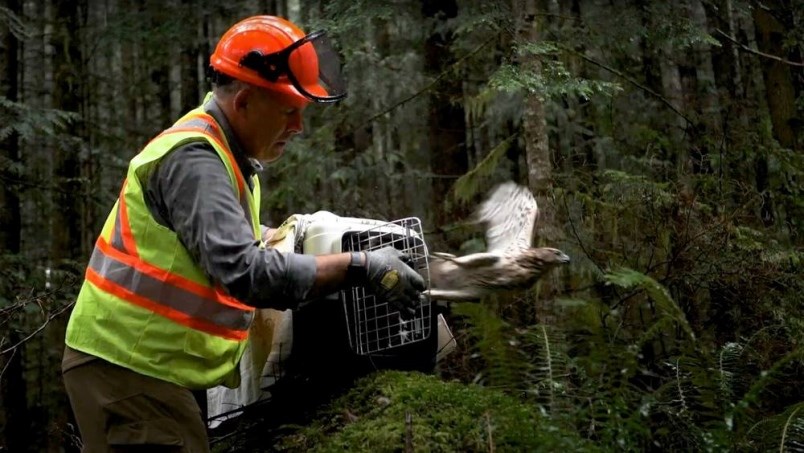A northern goshawk chick that fell out of its nest is back in the wild after a two-month rehabilitation at the MARS Wildlife Recovery Centre in Merville.
The northern goshawk is the largest accipiter hawk in B.C., and is considered a threatened species in Canada.
The chick was discovered on June 22 on Mosaic Forest Management Corp.’s private lands near Mount Washington by staff biologist David Vey.
It was a case of being in the right place at the right time, Vey said.
“Northern goshawk don’t necessarily breed every year, and we map all nests to properly monitor the goshawks,” Vey said in a statement. “I was working in the field conducting breeding-area monitoring when I found an active nest and saw a single nestling in the nest, so I approached the nest tree and I found a second chick sitting on the ground staring at me with his shocking blue eyes.”
The height of the nest made returning the chick impossible, so Vey brought the northern goshawk to the MARS Wildlife Rescue Centre.
Mosaic is a longtime supporter of MARS, and the volunteer team at the Wildlife Rescue Centre have the expertise and infrastructure to care for raptors in distress.
“The chick was very dehydrated, so it had probably been on the ground for a while,” said MARS caregiver Joanne Stiles. “During my seven years I have worked and volunteered for the Mars Wildlife Rescue, I have only seen three northern goshawk. It has truly been a unique experience to help rescue this beautiful goshawk who made a full recovery on its way back to its natural habitat.”
The bird was released on Aug. 20.
The coastal subspecies of the northern goshawk is considered threatened in Canada, with the entire Canadian population of the coastal subspecies found in B.C.
In its assessment of the bird in 2013, the federal government said the species favours mature coniferous forest. It needs a relatively large home range that contains a good food supply. “Despite some recent habitat protection efforts, continuing habitat loss is predicted, in part because of anticipated short rotation times in forest harvest,” the assessment said.
Mosaic said it has detailed procedures to identify, monitor and protect northern goshawk habitat within its managed private forest lands.
According to Cornell Lab of Ornithology, goshawk is derived from the Old English word for “goose hawk,” a reference to this raptor’s habit of preying on birds. Falconers have trained goshawks for more than 2,000 years; the birds were once called “cook’s hawk” for their success at snaring meat for the pot.
Northern goshawk pairs build and maintain up to eight alternate nests within their nesting area. Even with options available, they might use the same nest year after year, or might switch to a new nest after a brood fails.
The northern goshawk is well known for its fierce defence of its nest. It commonly attacks people and other animals that approach the nest too closely.
Attila the Hun wore an image of a northern goshawk on his helmet.
Read more from the Times Colonist



